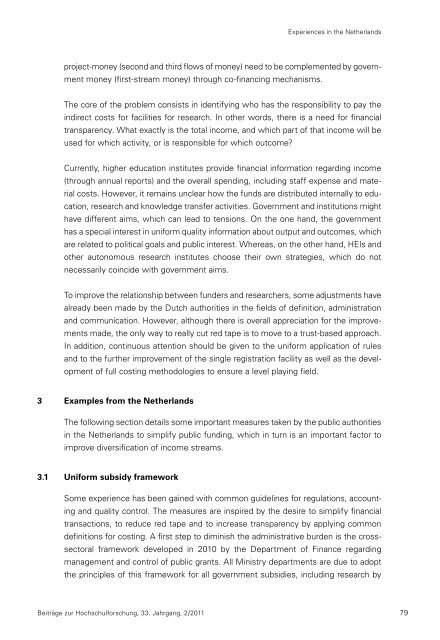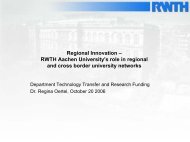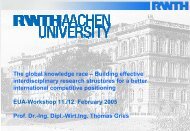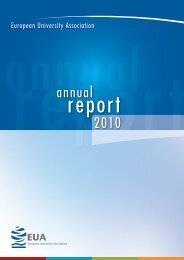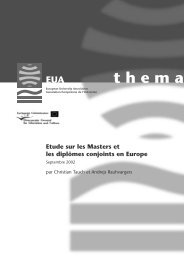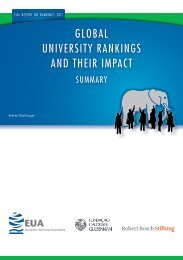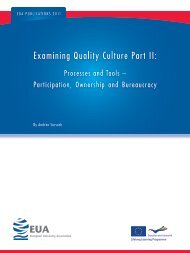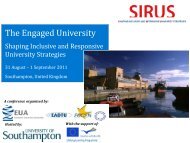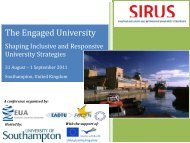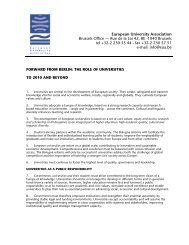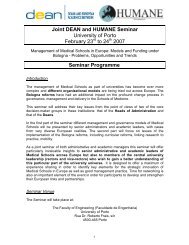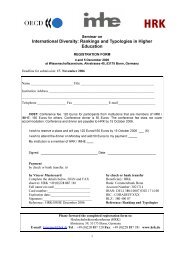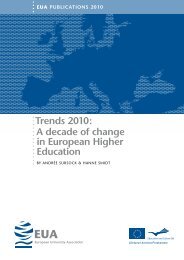Beiträge zur Hochschulforschung - European University Association
Beiträge zur Hochschulforschung - European University Association
Beiträge zur Hochschulforschung - European University Association
You also want an ePaper? Increase the reach of your titles
YUMPU automatically turns print PDFs into web optimized ePapers that Google loves.
Experiences in the Netherlands<br />
project-money (second and third flows of money) need to be complemented by govern-<br />
ment money (first-stream money) through co-financing mechanisms.<br />
The core of the problem consists in identifying who has the responsibility to pay the<br />
indirect costs for facilities for research. In other words, there is a need for financial<br />
transparency. What exactly is the total income, and which part of that income will be<br />
used for which activity, or is responsible for which outcome?<br />
Currently, higher education institutes provide financial information regarding income<br />
(through annual reports) and the overall spending, including staff expense and mate-<br />
rial costs. However, it remains unclear how the funds are distributed internally to edu-<br />
cation, research and knowledge transfer activities. Government and institutions might<br />
have different aims, which can lead to tensions. On the one hand, the government<br />
has a special interest in uniform quality information about output and outcomes, which<br />
are related to political goals and public interest. Whereas, on the other hand, HEIs and<br />
other autonomous research institutes choose their own strategies, which do not<br />
necessarily coincide with government aims.<br />
To improve the relationship between funders and researchers, some adjustments have<br />
already been made by the Dutch authorities in the fields of definition, administration<br />
and communication. However, although there is overall appreciation for the improve-<br />
ments made, the only way to really cut red tape is to move to a trust-based approach.<br />
In addition, continuous attention should be given to the uniform application of rules<br />
and to the further improvement of the single registration facility as well as the devel-<br />
opment of full costing methodologies to ensure a level playing field.<br />
3 Examples from the Netherlands<br />
The following section details some important measures taken by the public authorities<br />
in the Netherlands to simplify public funding, which in turn is an important factor to<br />
improve diversification of income streams.<br />
3.1 Uniform subsidy framework<br />
Some experience has been gained with common guidelines for regulations, account-<br />
ing and quality control. The measures are inspired by the desire to simplify financial<br />
transactions, to reduce red tape and to increase transparency by applying common<br />
definitions for costing. A first step to diminish the administrative burden is the cross-<br />
sectoral framework developed in 2010 by the Department of Finance regarding<br />
management and control of public grants. All Ministry departments are due to adopt<br />
the principles of this framework for all government subsidies, including research by<br />
<strong>Beiträge</strong> <strong>zur</strong> <strong>Hochschulforschung</strong>, 33. Jahrgang, 2/2011 79


